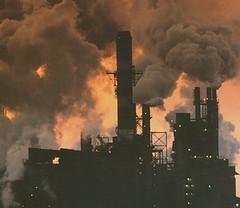 If you have any question about where the balance of power in the world is heading, check out this article from Mother Jones entitled “The Last Empire: Can the world survive China’s rush to emulate America’s way of life?”
If you have any question about where the balance of power in the world is heading, check out this article from Mother Jones entitled “The Last Empire: Can the world survive China’s rush to emulate America’s way of life?”
The grander astonishment is the most massive and rapid redistribution of the earth’s resources in human history. In a mere two and a half decades, China has awakened from Maoist stagnancy to become the world’s manufacturer. Among the planet’s 193 nations, it is now first in production of coal, steel, cement, and 10 kinds of metal; it produces half the world’s cameras and nearly a third of its TVs, and by 2015 may produce the most cars. It boasts factories that can accommodate 200,000 workers, and towns that make 60 percent of the world’s buttons, half the world’s silk neckties, and half the world’s fireworks, respectively.
China has also become a ravenous consumer. Its appetite for raw materials drives up international commodity prices and shipping rates while its middle class, projected to jump from fewer than 100 million people now to 700 million by 2020, is learning the gratifications of consumerism. China is by a wide margin the leading importer of a cornucopia of commodities, including iron ore, steel, copper, tin, zinc, aluminum, and nickel. It is the world’s biggest consumer of coal, refrigerators, grain, cell phones, fertilizer, and television sets. It not only leads the world in coal consumption, with 2.5 billion tons in 2006, but uses more than the next three highest-ranked nations—the United States, Russia, and India—combined. China uses half the world’s steel and concrete and will probably construct half the world’s new buildings over the next decade. So omnivorous is the Chinese appetite for imports that when the country ran short of scrap metal in early 2004, manhole covers disappeared from cities all over the world—Chicago lost 150 in a month. And the Chinese are not just vast consumers, but conspicuous ones, as evidenced by the presence in Beijing of dealers representing every luxury-car manufacturer in the world. Sales of Porsches, Ferraris, and Maseratis have flourished, even though their owners have no opportunity to test their finely tuned cars’ performance on the city’s clotted roads.
The catch is that China has become not just the world’s manufacturer but also its despoiler, on a scale as monumental as its economic expansion. . . .A fourth of the country is now desert. More than three-fourths of its forests have disappeared. Acid rain falls on a third of China’s landmass, tainting soil, water, and food. Excessive use of groundwater has caused land to sink in at least 96 Chinese cities, producing an estimated $12.9 billion in economic losses in Shanghai alone. Each year, uncontrollable underground fires, sometimes triggered by lightning and mining accidents, consume 200 million tons of coal, contributing massively to global warming. A miasma of lead, mercury, sulfur dioxide, and other elements of coal-burning and car exhaust hovers over most Chinese cities; of the world’s 20 most polluted cities, 16 are Chinese.
The government estimates that 400,000 people die prematurely from respiratory illnesses each year, and health care costs for premature death and disability related to air pollution is estimated at up to 4 percent of the country’s gross domestic product. Four-fifths of the length of China’s rivers are too polluted for fish. Half the population—600 or 700 million people—drinks water contaminated with animal and human waste. Into Asia’s longest river, the Yangtze, the nation annually dumps a billion tons of untreated sewage; some scientists fear the river will die within a few years. Drained by cities and factories all over northern China, the Yellow River, whose cataclysmic floods earned it a reputation as the world’s most dangerous natural feature, now flows to its mouth feebly, if at all. China generates a third of the world’s garbage, most of which goes untreated. Meanwhile, roughly 70 percent of the world’s discarded computers and electronic equipment ends up in China, where it is scavenged for usable parts and then abandoned, polluting soil and groundwater with toxic metals.
Remember that Pluto rules over breakdown and destruction, followed by transformation. The elevation of Ceres to planet status has coincided with the eruption into mass consciousness of an acceptance (finally!!) of the need to protect the planet’s resources. Capricorn is concerned with matters of business, factories, governments, anywhere things are made and commerce is conducted. The emergence of China as a world power, without the democracy that helps to put safeguards in place, is likely to be the focal point of the Pluto in Capricorn period. Already we are seeing the emergence of a deadly “people’s revolution” to protest the devastation of the environment there that is likely to come to a head with the upcoming square of Uranus in Aries to Pluto in Capricorn.
This article is a must read.

